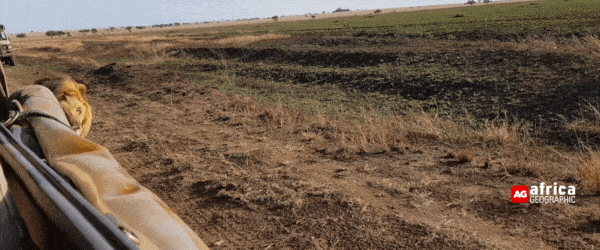
CEO NOTE: 30 April 2021
This is a copy of our weekly email newsletter. Subscribe here to receive the newsletter.
 Last week we published an incredible gallery by Kenyan guide and Photographer of the Year entrant James Nampaso – of lions targeting a mom giraffe and her tiny calf. Like many of you, I suspect, images like this toy with my emotions – although of course I respect the necessity of this brutal process playing itself out in countless ways in the natural world. After seeing the above gallery, Barbara Westbrook from Australia sent us an enthralling video clip of a similar encounter of a few years back – in the same area. Again, such a brave giraffe mom and calf. This time though, the outcome was different – watch the video featured after our stories below.
Last week we published an incredible gallery by Kenyan guide and Photographer of the Year entrant James Nampaso – of lions targeting a mom giraffe and her tiny calf. Like many of you, I suspect, images like this toy with my emotions – although of course I respect the necessity of this brutal process playing itself out in countless ways in the natural world. After seeing the above gallery, Barbara Westbrook from Australia sent us an enthralling video clip of a similar encounter of a few years back – in the same area. Again, such a brave giraffe mom and calf. This time though, the outcome was different – watch the video featured after our stories below.
Speaking of 2021 Photographer of the Year, May is the final month of entries, before we start the judging process in June. Some epic images already submitted are competing for the title, which comes with US$10,000 in prize money and a Botswana safari for the winner and two runners-up + their partners. Please get your entries in now to avoid the usual last-minute rush.
Keep the passion

Simon Espley – CEO, Africa Geographic
From our Editor-in-Chief
 ‘When is the best time to go to Africa?’ The safari guide’s eyes roll heavenward. He forces a smile and answers with something like, ‘You do realise that Africa straddles the equator, covers six time zones, is a vast area more than three times the size of the US of profoundly different vegetation, climate, topography, wildlife and home to over a billion souls of unimaginably diverse looks, languages and cultures. Which bit of Africa were you referring to exactly?’. Luckily for our jaded safari guide, we at AG have come to the rescue with a series of four stories about the best times to visit the many fascinating parts of Africa. In our first story below, we cover the most popular safari season of June to August.
‘When is the best time to go to Africa?’ The safari guide’s eyes roll heavenward. He forces a smile and answers with something like, ‘You do realise that Africa straddles the equator, covers six time zones, is a vast area more than three times the size of the US of profoundly different vegetation, climate, topography, wildlife and home to over a billion souls of unimaginably diverse looks, languages and cultures. Which bit of Africa were you referring to exactly?’. Luckily for our jaded safari guide, we at AG have come to the rescue with a series of four stories about the best times to visit the many fascinating parts of Africa. In our first story below, we cover the most popular safari season of June to August.
A few years ago, I was shooting a short documentary on the Maasai people who graze their livestock (legally) in the Mara Triangle during the quiet season. Even a blind moron with a faulty pinhole camera could have captured gorgeous images of the scene: backdrop of the Mara at sunrise, the Maasai’s colourful clothing and the odd elephant wandering past the cattle. What struck me most, however, was the fact that the herders, contrary to their cliched portrayal in popular media, are not relics of a bygone era. They were chatting on their smartphones and doing banking transactions dressed in shukas and car-tire sandals while whistling at their cattle. These were modern, 21st-century Maasai. In our second story below, Benoît Feron and Anne-Françoise Tasnier travelled to South Sudan to spend some time with the Mundari people; to learn about their cattle culture and photograph their interaction with the 21st century.
Our third story below is exciting. New research by the big hitters of African elephant conservation lead by Jake Wall with support from doyen Iain Douglas-Hamilton and many others, asserts that elephants occupy just 17% of their potential range. Whether we, as a species, can learn to share this land with them is another matter – but there is hope, and there is more space than we thought.

Story 1
https://travel.africageographic.com/when-to-go-on-safari
SAFARI TIPS
When is the best safari season in Africa? Learn the best places to visit for weather, wildlife and experiences
Story 2
https://africageographic.com/stories/the-mundari-of-south-sudan/
MUNDARI CULTURE
The Mundari people of South Sudan are a fascinating, traditional people forging into the 21st century with a cattle-based culture
Story 3
https://africageographic.com/stories/elephant-range-is-just-a-fraction-of-its-potential/
HOPE FOR ELEPHANTS
New research shows that Africa’s elephant range is just 17% of its potential. Despite the odds, there is potential for expansion.
Story 4
https://africageographic.com/stories/photographer-of-the-year-2021-weekly-selection-week-16/
BEST PHOTOS
Week sixteen of our 2021 Photographer of the Year
To comment on this story: Login (or sign up) to our app here - it's a troll-free safe place 🙂.![]()






